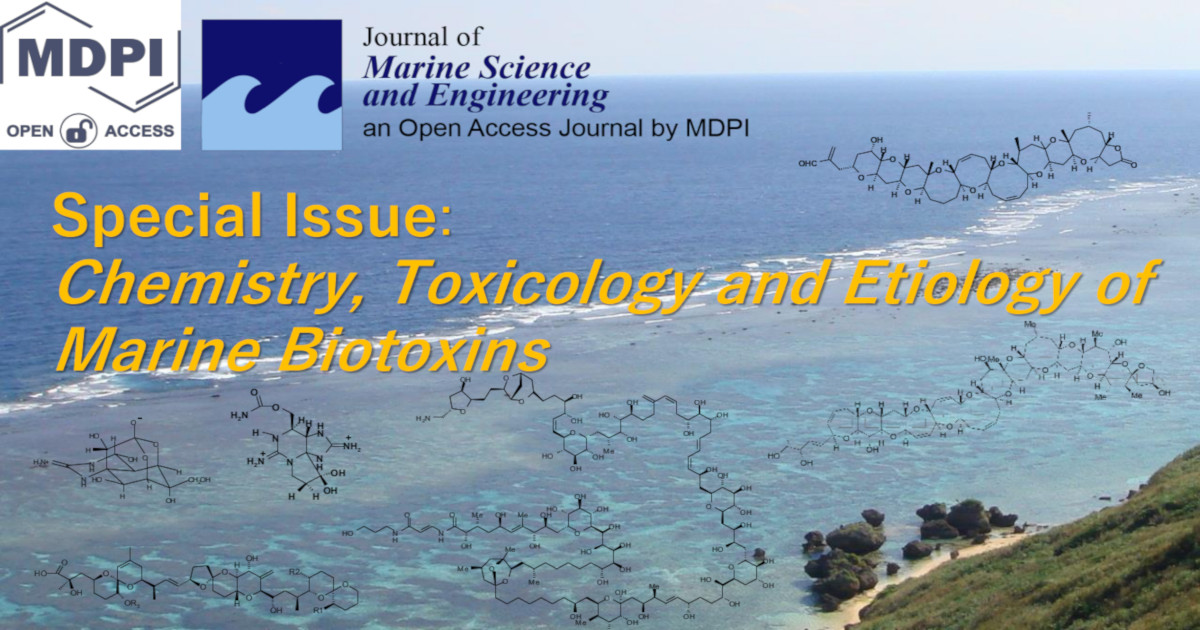Chemistry, Toxicology and Etiology of Marine Biotoxins
A special issue of Journal of Marine Science and Engineering (ISSN 2077-1312). This special issue belongs to the section "Marine Biology".
Deadline for manuscript submissions: closed (20 May 2022) | Viewed by 28942

Image courtesy of Naomasa OSHIRO
Special Issue Editors
Interests: analysis of marine biotoxins; chemistry and etiology of marine biotoxins; epidemiology of seafood poisoning; ciguatera poisoning
Special Issues, Collections and Topics in MDPI journals
Interests: analytical methods for algal toxins; chromatography; mass spectrometry; sample preparation; method validation
Special Issues, Collections and Topics in MDPI journals
Interests: toxicological studies; mechanism of toxicity; dermotoxicity; natural toxins; nanotoxicology
Special Issues, Collections and Topics in MDPI journals
Special Issue Information
Dear Colleagues,
Marine biotoxins are bioactive natural products that are primarily produced by microalgae and bacteria. These toxins affect aquatic organisms and human health. The blooming of dinoflagellate or diatom species leads to the poisoning of plankton-feeding bivalve mollusks, inducing paralytic, diarrheic, neurologic, and amnesic shellfish poisoning. Following the elucidation of the appearance patterns of these microalgae and the principal toxin structures, the risk of shellfish poisoning by monitoring plankton and toxins has been avoided.
Palytoxin analogs including ovatoxins are responsible for respiratory disorders and dermatitis in the exposure of people to marine aerosols during Ostreopsis cf. ovata blooms as well as to some aquarium containing corals. Also, they may be implicated in clupeotoxism food poisoning due to the consumption of Clupeidae fish.
While important progress has been made recently in the identification of the main toxins associated with ciguatera and pufferfish poisoning, further investigation on the identification and structural elucidation of new analogs, transmission, and accumulation modes is required. In addition, the isolation and structure elucidation of Indian Ocean ciguatoxin, charcheatoxin, and the substances implicated in Haff disease and similar type of intoxication are issues of interest in this field.
This Special Issue aims to present a collection of new findings on the chemical, toxicological, and etiological aspects of marine biotoxins, as well as observations and evidence in health risk assessment, analysis, and management, which might contribute to the research areas mentioned above. Topics of interest include isolation and structure elucidation, the development and/or validation of analysis methods, the monitoring of toxins, toxicology and mechanisms of action, outbreak reports, and epidemiological observations.
Dr. Naomasa Oshiro
Prof. Dr. Ana Gago-Martínez
Prof. Dr. Aurelia Tubaro
Guest Editors
Manuscript Submission Information
Manuscripts should be submitted online at www.mdpi.com by registering and logging in to this website. Once you are registered, click here to go to the submission form. Manuscripts can be submitted until the deadline. All submissions that pass pre-check are peer-reviewed. Accepted papers will be published continuously in the journal (as soon as accepted) and will be listed together on the special issue website. Research articles, review articles as well as short communications are invited. For planned papers, a title and short abstract (about 100 words) can be sent to the Editorial Office for announcement on this website.
Submitted manuscripts should not have been published previously, nor be under consideration for publication elsewhere (except conference proceedings papers). All manuscripts are thoroughly refereed through a single-blind peer-review process. A guide for authors and other relevant information for submission of manuscripts is available on the Instructions for Authors page. Journal of Marine Science and Engineering is an international peer-reviewed open access monthly journal published by MDPI.
Please visit the Instructions for Authors page before submitting a manuscript. The Article Processing Charge (APC) for publication in this open access journal is 2600 CHF (Swiss Francs). Submitted papers should be well formatted and use good English. Authors may use MDPI's English editing service prior to publication or during author revisions.
Keywords
- shellfish poisons (PSP, DSP, ASP and NSP)
- ciguatoxin
- palytoxin
- tetrodotoxin
- phycotoxin
- cyanotoxin
- toxicology
- food safety
- epidemiology







